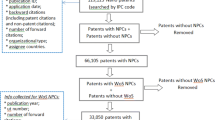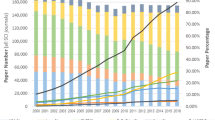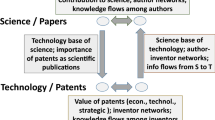Abstract
There is a rich literature on how science and technology are related to each other. Patent citation analysis is amongst the most frequently used to tool to track the strengths of links. In this paper we explore the relationship between patent citations and citation impact in nanoscience. Our observations indicate that patent-cited papers perform better in terms of standard bibliometric indicators than comparable publications that are not linked to technology in this way. More specifically, we found that articles cited in patents are more likely to be cited also by other papers. The share of highly cited papers is the most striking result. Instead of the average of 4% of all papers, 13.8% of the papers cited once or twice in patents fall into this category and even 23.5% of the papers more frequently cited in patents receive citation rates far above the standard. Our analyses further demonstrate the presence and the relevance of bandwagon effects driving the development of science and technology.


Similar content being viewed by others
References
Baldini, N. (2008). Negative effects of University Patenting: Myths and grounded. Scientometrics, 75(2), 289–311.
Bassecoulard, E., & Zitt, M. (2004). Patents and publications: The lexical connection. In H. F. Moed, W. Glänzel, & U. Schmoch (Eds.), Handbook of quantitative science and technology research: The use of publication and patent statistics in studies of S&T systems (pp. 665–694). Dordrecht: Kluwer Academic Publishers.
Braun, T., & Glänzel, W. (1990). United Germany: The new scientific superpower? Scientometrics, 19(5–6), 513–521.
Braun, T., Glänzel, W., & Schubert, A. (1985). Scientometric indicators. A 32 country comparison of publication productivity and citation impact. Singapore and Philadelphia: World Scientific Publishing.
Brusoni, S., Prencipe, A., & Pavitt, K. (2001). Knowledge specialization, organizational coupling, and the boundaries of the firm: Why do firms know more than they make? Administrative Science Quarterly, 46(4), 597–621.
Czarnitzki, D., Glänzel, W., & Hussinger, K. (2007). Patent and publication activities of German professors: An empirical assessment of their co-activity. Research Evaluation, 16(4), 311–319.
Czarnitzki, D., Glänzel, W., & Hussinger, K. (2009). Heterogeneity of patenting activity and its implication for scientific research. Research Policy, 38(1), 26–34.
Debackere, K., & Rappa, M. A. (1994). Institutional variations in problem choice and persistence among scientists. Research Policy, 23(4), 425–441.
Etzkowitz, H., & Leydesdorff, L. (1997). Universities and the global knowledge economy: A triple helix of university-industry-government relations. London: Pinter.
Geuna, A., & Nesta, L. (2006). University patenting and its effects on academic research: The emerging European evidence. Research Policy, 35(6), 790–807.
Gibbons, M., Limoges, C., Nowotny, H., Schwartzmann, S., Scott, P., & Trow, M. (1994). The new production of knowledge: The dynamics of science and research in contemporary societies. London: Sage.
Glänzel, W. (2001). National characteristics in international scientific co-authorship relations. Scientometrics, 51(1), 69–115.
Glänzel, W. (2007). Characteristic scores and scales. A bibliometric analysis of subject characteristics based on long-term citation observation. Journal of Informetrics, 1(1), 92–102.
Glänzel, W., & Meyer, M. (2003). Patents cited in the scientific literature: An exploratory study of ‘reverse’ citation relations in the triple helix. Scientometrics, 58(2), 415–428.
Glänzel, W., & Schubert, A. (2003). A new classification scheme of science fields and subfields designed for scientometric evaluation purposes. Scientometrics, 56(3), 357–367.
Glänzel, W., Meyer, M., Schlemmer, B., Du Plessis, M., Thijs, B., Magerman, T., Debackere, K., & Veugelers, R. (2003). Nanotechnology—analysis of an emerging domain of scientific and technologic endeavour. Accessible via: http://www.ecoom.be/nanotech_domain_study.pdf.
Glänzel, W., Debackere, K., & Meyer, M. (2008). ‘Triad’ or ‘tetrad’? On global changes in a dynamic world. Scientometrics, 74(1), 71–88.
Glänzel, W., Schubert, A., Thijs, B., & Debackere, K. (2009). Subfield-specific normalized relative indicators and a new generation of relational charts: Methodological foundations illustrated on the assessment of institutional research performance. Scientometrics, 78(1), 165–188.
Granstrand, O., Patel, P., & Pavitt, K. (1997). Multitechnology corporations: Why they have ‘distributed’ rather than ‘distinctive core’ capabilities. California Management Review, 39, 8–25.
Hicks, D. (2000). 360 degree linkage analysis. Research Evaluation, 9, 133–143.
Hullmann, A., & Meyer, M. (2003). Publications and patents in nanotechnology—an overview of previous studies and the state of the art. Scientometrics, 58(3), 507–527.
Katz, J. S. (2005). Scale-independent bibliometric indicators. Measurement, 3(1), 24–28.
Kumaramangalam, K. (2004). Does collaborating with academia improve industry science? Evidence from the UK Biotechnology Sector, 1988–2001. ASLIB Proceedings, 57(3), 261–277.
Kuusi, O., & Meyer, M. (2002). Technological generalizations and leitbilder—the anticipation of technological opportunities. Technological Forecasting and Social Change, 69(6), 625–639.
Langlois, R. N. (1992). Transaction costs economics in real time. Industrial and Corporate Change, 1, 99–127.
Meyer, M. (2000). Does science push technology? Patents citing scientific literature. Research Policy, 29(3), 409–434.
Meyer, M. (2001). Patent citation analysis in a novel field of technology: An exploration of nano-science and nano-technology. Scientometrics, 51(1), 163–183.
Meyer, M. (2006). Are patenting scientists the better scholars? An exploratory comparison of inventor-authors with their non-inventing peers in nano-science and technology. Research Policy, 35(10), 1646–1662.
Meyer, M. (2007). What do we know about innovation in nanotechnology? Some propositions about an emerging field between hype and path-dependency. Scientometrics, 70(3), 779–810.
Meyer, M., & Persson, O. (1998). Nanotechnology—interdisciplinarity, patterns of collaboration and differences in application. Scientometrics, 42(2), 195–205.
Miyazaki, K., & Islam, N. (2007). Nanotechnology systems of innovation—an analysis of industry and academia research activities. Technovation, 27, 661–675.
Narin, F., & Noma, E. (1985). Is technology becoming science? Scientometrics, 7, 369–381.
Narin, F., Hamilton, K. S., & Olivastro, D. (1995). Linkage between agency supported research and patented industrial technology. Research Evaluation, 5, 183–187.
Narin, F., Hamilton, K. S., & Olivastro, D. (1997). The increasing linkage between US technology and public science. Research Policy, 26(3), 317–330.
NSTC (National Science and Technology Council). (2002). National nanotechnology initiative: The initiative and its implementation plan (FY 2003). Report, June 2002.
Porter, A. L. & Rafols, I. (2009). Is science becoming more interdisciplinary? Measuring and mapping six research fields over time. Manuscript under review, available at http://www.sussex.ac.uk/spru/profile167630.html.
Porter, A. L., & Youtie, J. (2009). How interdisciplinary is nanotechnology? Journal of Nanoparticle Research, 11, 1023–1041.
Price, D. J. D. (1965). Is technology historically independent of science—a study in statistical historiography. Technology and Culture, 6(4), 553–568.
Rafols, I., Park, J.-H., & Meyer, M. (2010, forthcoming). Hybrid nanomaterial research: Is it really interdisciplinary? In K. Rurack & R. Martínez-Máñez (Eds.), The supramolecular chemistry of organic-inorganic hybrid materials. Hoboken, NJ, USA: Wiley.
Rip, A. (1992). Science and technology as dancing partners. In P. Kroes & M. Bakker (Eds.), Technological development and science in the industrial age (pp. 231–270). Dordrecht: Kluwer.
Schummer, J. (2004). Multidisciplinarity, interdisciplinarity, and patterns of research collaboration in nanoscience and nanotechnology. Scientometrics, 59, 425–465.
Stokes, D. (1997). Pasteur’s quadrant: Basic science and technological innovation. Washington: Brookings Institution Press.
van Looy, B., Zimmermann, E., Veugelers, R., Verbeek, A., Mello, J., & Debackere, K. (2003). Do science–technology interactions pay off when developing technology? Scientometrics, 57(3), 355–367.
van Looy, B., Debackere, K., Callaert, J., Tijssen, R., & van Leeuwen, T. (2006). Scientific capabilities and technological performance of national innovation systems: An exploration of emerging industrial relevant research domains. Scientometrics, 66(2), 295–310.
van Raan, A. F. J. (2005). Reference-based publication networks with episodic memories. Scientometrics, 63(3), 549–566.
Author information
Authors and Affiliations
Corresponding author
Rights and permissions
About this article
Cite this article
Meyer, M., Debackere, K. & Glänzel, W. Can applied science be ‘good science’? Exploring the relationship between patent citations and citation impact in nanoscience. Scientometrics 85, 527–539 (2010). https://doi.org/10.1007/s11192-009-0154-3
Received:
Published:
Issue Date:
DOI: https://doi.org/10.1007/s11192-009-0154-3




